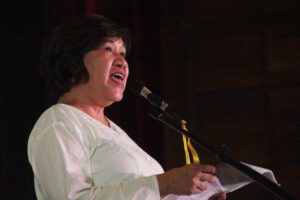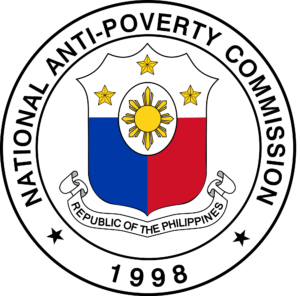
(UPDATED) “Ang immediate concern ko ay mapalakas ang kapasidad at boses ng mga mahihirap para itulak ang social reforms at matiyak ang pakinabang nila dito [My immediate concern is to strengthen the capacity and voice of the poor to push for social reforms and ensure that they benefit from it],” the newly appointed National Anti-Poverty Commission (NAPC) chief Liza Maza replied in a text message to Manila Today.
The Presidential Communications Operations Office announced yesterday that former Gabriela Women’s Party Representative Liza Largoza Maza is NAPC’s new Lead Convener.
Maza was a member of the House of Representatives in the 12th Congress representing Bayan Muna Party-list and Gabriela Women’s Party during the 13th and 14th Congress. Maza is an activist since her college days in the University of the Philippines (UP) while studying BS Business Economics. A staunch women’s rights advocate, Maza served as Secretary-General of GABRIELA for 14 years and is currently the head of the International Women’s Alliance (IWA). She co-chairs Koalisyong Makabayan, a coalition of progressive Party-list organizations. Maza has been in the forefront of people’s struggle for women’s rights, pro-people economy, against corruption and foreign domination in the streets and in the halls of Congress.
NAPC mandate
 “Ang mandate ng NAPC ay i-coordinate, i-monitor at i-evaluate ang implementation ng social reform at poverty alleviation programs ng government at palahukin ang mga batayang sektor sa paggawa ng mga programa para maibsan ang kahirapan at matiyak na natutugunan ang kanilang mga pangangailangan [NAPC’s mandate is to coordinate, monitor and evaluate the implementation of social reform and poverty alleviation programs of the government and ensure the participation of the basic sectors in drawing poverty alleviation programs and ensure that their needs are addressed],” according to Maza.
“Ang mandate ng NAPC ay i-coordinate, i-monitor at i-evaluate ang implementation ng social reform at poverty alleviation programs ng government at palahukin ang mga batayang sektor sa paggawa ng mga programa para maibsan ang kahirapan at matiyak na natutugunan ang kanilang mga pangangailangan [NAPC’s mandate is to coordinate, monitor and evaluate the implementation of social reform and poverty alleviation programs of the government and ensure the participation of the basic sectors in drawing poverty alleviation programs and ensure that their needs are addressed],” according to Maza.
NAPC was formed in 1998 through Republic Act 8425 or Social Reform and Poverty Alleviation Act of 1997.
The Commission grouped the basic sectors into artisanal fisher folk, children, cooperatives, farmers and landless rural workers, indigenous people and cultural communities, non-government organizations, persons with disabilities, senior citizens, urban poor, victims of disasters and calamities, women, formal labor and migrant workers, workers in the informal sector, and youth and students.
NAPC in the past 5 years
In an article written by NAPC’s former Lead Convener Joel Rocamora for the latest issue of ‘Batingaw’, NAPCs’ Basic Sectors publication, he wrote that the Commission focused on establishing fish landings for small fisher folks, campaigning for the return of the multi-billion Coco Levy fund, and creating a People’s Plan for the urban poor and the bottom-up budgeting (BUB).
But the Akbayan-led NAPC was riddled with corruption issues with the coco levy fund and questions on hiring of consultants.
Peasant organization Kilusang Magbubukid ng Pilipinas (KMP) alleged back in 2013 that Rocamora tried to access around P1.6 million for it’s ‘bogus anti-coconut farmers program’ from the P71 billion coco levy funds that the Supreme Court ordered to be released.
However, Rocamora denied the allegations.
In 2012, the Commission on Audit (COA) questioned Rocamora’s P28 million spending for NAPC’s consultants.
At the height of the anti-pork barrel campaign, groups also questioned the implementation of BUB in the local government which they claim as hidden pork barrel due that lump-sum funds were being allocated under BUB. The BUB expanded the President’s discretion over local projects making it what Kabataan Partylist referred to in 2013 as the Executive Department’s pork barrel fundit the Executive Department’s pork barrel fund. The BUB was introduced in 2012 by the Department of Interior and Local Government then headed by Mar Roxas.
On the other hand, NAPC’s People’s Plan for the urban poor that aims for the participation of the urban poor in the planning, decision making and implementation of the government’s housing program for the poor went by unfelt.

According to Karapatan, 11,734 are documented victims of demolition under the Benigno Aquino III administration. In addition, the situation of relocatees in government-assigned relocation areas in different parts of Metro Manila and nearby provinces has worsened. Lack of job opportunities and livelihood and inefficient and/or lack of social services in the relocation sites are recurring problems. Many have also failed to pay the amortization of the houses threatening their displacement anew, such as the case of 1,058 houses in Southville 3 in Cavite.
Challenges for the next NAPC chief
In the coming months, Maza said that she would conduct consultations with different sectors on how she can ensure the people’s participation and benefits in the implementing the government’s social reforms and poverty alleviation programs.

During President Duterte’s visit to Tondo, Manila the night of his inauguration, he said that among his top priority to address poverty is education, health care, and agriculture to ensure food security. He assured the people that funds from the government would be available for these.
“Simple lang ang hiling ko, bayan na kumportable yung tao, walang gutom, at kung maaari lang ay may hanapbuhay ang lahat,” said Duterte.






























